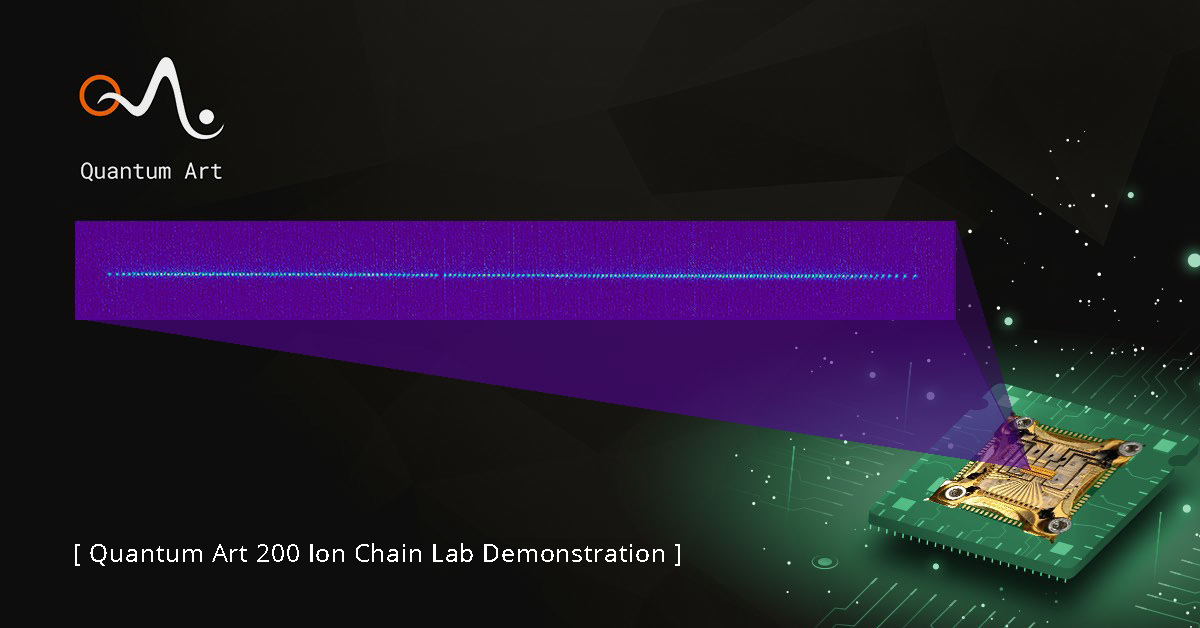200-ion Chain Demonstration Validates Essential Scalability Pillar in Race Toward Commercial Quantum Computing
NESS ZIONA, ISRAEL - July 30, 2025 (NEWMEDIAWIRE) - Quantum Art, a developer of full-stack quantum computers built on trapped-ion qubits and a proprietary scale-up architecture, has demonstrated one of the longest linear ion chains ever achieved in an industry grade quantum system. The 200-ion chain, spaced at 5 microns from each other, highlights the company’s precision trap engineering and confirms a key element of its scalable, multi-core architecture.

The demonstration reflects the successful integration of all critical fabrication and environmental control elements needed for stable long-chain operation. These include precise trap geometry and electrode fabrication, extremely low heating rates, minimal stray and residual fields, low-noise RF and DC control, and a cryogenic environment that enables continuous operation with low susceptibility to external disturbances. Careful trap-chip engineering allowed Quantum Art to overcome the zig-zag instability that typically plagues long ion crystals, and remain with a perfectly linear crystal that is necessary for precision quantum gates.
Quantum Art’s systems operate under ultra-stable cryogenic conditions designed to minimize micro-motion and maintain consistent spatial separation between ions. The successful formation of the 200-ion chain confirms the company’s ability to engineer ion traps with the quality and scale necessary to support 1D crystals extending into the hundreds and beyond.
“Scaling quantum systems to thousands and ultimately millions of qubits requires architectural innovation and hardware built to scale,” said Dr. Tal David, CEO and co-founder of Quantum Art. “This result is not just a demonstration of control of 200 ions, it’s a validation of our advanced trap engineering and how it produces the system stability needed to support our multi-core, reconfigurable quantum architecture. These long ion chains form the physical backbone of our roadmap to scalable, commercially viable quantum computing.”
Most trapped-ion systems top out around 30 to 50 ions. By stabilizing 200 ions, Quantum Art is opening the door to future systems with 1,000-ion registers, composed of modular, optically segmented cores that operate in parallel with dynamic reconfigurability and high qubit connectivity.
“Creating long, stable ion chains at this scale is an exceptional hardware challenge that requires precise control over every aspect of the trap environment,” said Dr. Amit Ben-Kish, CTO and co-founder of Quantum Art. “To stabilize 200 ions in a fully linear configuration, we engineered a trap platform with low-noise DC and RF fields, ultra-low heating rates, low stray fields and high mechanical and thermal stability, allowing for a stable crystal configuration. This result confirms that our system can support very long 1D crystals, in our segmented multi-core approach, addressing the required coherent control operations and fidelities for scalable quantum logic operations.”
The 200-ion result advances Quantum Art’s roadmap, supporting both near-term and long-term goals. The company is working to prepare for a commercial release of its Montage system (50 qubits), while simultaneously developing its Perspective platform - a 1,000 physical-qubit quantum processing unit (QPU) expected to demonstrate commercial quantum advantage by 2027. The Perspective platform will rely on large ion chains like the one demonstrated, segmented into optically reconfigurable cores that operate in parallel without shuttling or photonic links.
This result underscores the viability of Quantum Art’s unique approach to scale, which centers around four architectural pillars: multi-qubit gate operations, dynamic optical segmentation into independently operating cores, reconfigurable core arrays, and high-density 2D layouts. Long ion registers, such as the 200-ion chain demonstrated here, are a cornerstone of this design - enabling large, parallelized quantum processors within a compact footprint.
Media Contact
Kyle Porter
EVP – Managing Director
Virgo Public Relations
quantum@virgo-pr.com
+1 212-584-4289
